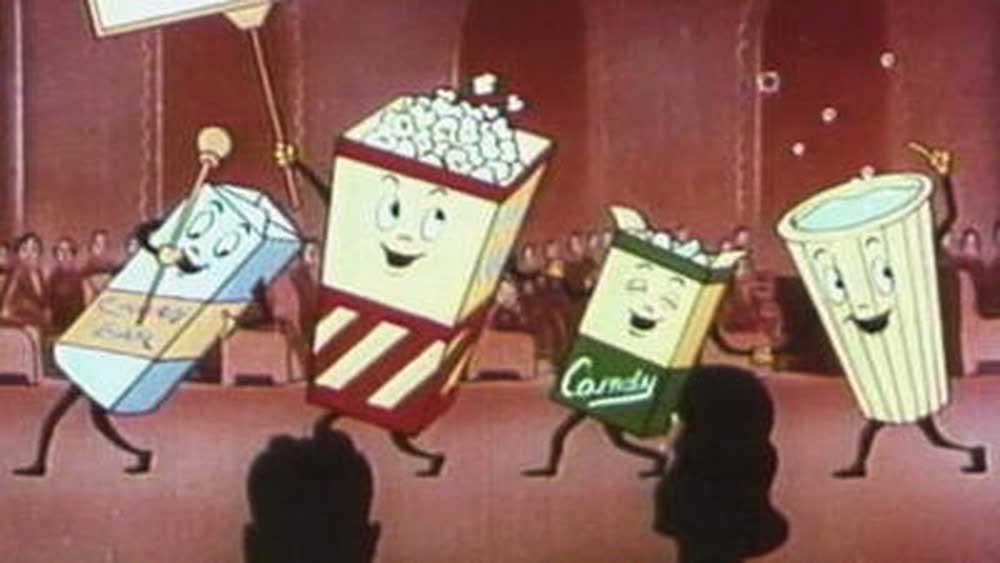How popcorn popped up at the movies
Published 1:45 am Thursday, June 25, 2020

- A still from “Let’s All Go to the Lobby” (1957) advertisement, officially called “Technicolor Refreshment Trailer No. 1,” that ran before films and during intermission. The ad was selected in 2000 to be entered into the National Film Registry by the Library of Congress.
Movie snacks come in all shapes and sizes, and whether they are sweet, chocolatey or salty, one movie munchie reigns supreme — the almighty kernel of buttery goodness that is popcorn.
The full sensory snack and movies have walked hand in hand for nearly a century and, even though the reopening of cinemas across the country could alter how we can watch films, movie’s perfect snack will remain.
According to The Popcorn Board, a nonprofit funded by popcorn processors, Americans consume an average of 15 billion quarts of popcorn per year, tallying 1.146 billion pounds of the stuff in 2018, this includes what is popped at home and in commercial settings.
But how did it reach that milestone and why can’t audiences get enough of the tubs of popcorn they consume en masse every year?
The history of the beloved snack starts about 8,000 years ago when a strain of maize began to be cultivated and one strain of it was called, aptly, popcorn. These hard kernels would help build up pressure when mixed with heat then explode into a digestible snack. It was grown, sold and traded throughout South America.
By the early 19th century, North American whalers returning from Chile would bring the strain of corn back with them, spreading quickly when people found it both tasty
and entertaining to watch the corn pop.
When the first-steam powered popcorn maker made its debut, the popularity of the snack exploded as sellers were able to easily transport, make and sell the snack anywhere without the hindrance of a full kitchen.
The smell of freshly popped popcorn didn’t hurt sales either.
Movie theaters, however, refused to sell the confection. Many early cinemas aimed their business toward a highbrow clientele and featured opulent decorations like playhouses before them. Since films were presented without sound, patrons needed to be able to read the title cards presented throughout the films, which limited how many people could fully understand what was happening as illiteracy rates numbered 4% for white Americans, 13.1% for foreign-born white Americans and 23% for people of color in 1920 according to census records for that year.
All that began to shift by 1927 when movies got sound. Literacy wasn’t a requirement to watch and enjoy a movie, so more patrons began to visit movie houses. Still, snacks were absent from the picture.
Then the stock market crashed.
People flocked to the movies for any distraction from the harsh reality of the Great Depression. By 1930, attendance soared to 90 million per week.
They longed for cheap and easy entertainment wherever they could find it, and popcorn vendors saw an opportunity. They would set up their carts outside the lobbies of theaters selling bags of popcorn for 5 to 10 cents. For the vendors, the return on investment was good — popcorn was cheap and a bag of the unpopped kernels could last them years.
Patrons would buy bags of the stuff and even smuggle it into the theaters who still frowned on the snack’s presence in their auditoriums.
Most theaters didn’t have space or proper ventilation to accommodate a concession stand so a few began offering leases to popcorn vendors to bring their operations inside or just outside the doors.
As the Depression continued, theaters decided to cut out the middleman and sell their own snacks. Since the overhead was low, the theater’s profits soared.
The snack was now in demand, and theaters that didn’t sell their own concessions saw their bankroll suffer and likely failed because of it.
By World War II, popcorn again saw a surge in popularity as sugar was rationed, severely limiting candies and sodas available. Popcorn and salt, however, didn’t experience the same shortage.
By 1945, more than half of the popcorn consumed in the United States was done at the movies.
Concessions became a major moneymaker, and theaters took the opportunity to push their foods with ads that would run before and during the intermission of movies reminding people to “go to the lobby to get (themselves) a treat.”
Despite the catchy tunes though, popcorn sales began to decrease in the mid-1950s through the 1960s as a new technology kept people from going to the movies as much: television.
By this point, popcorn was difficult and time-consuming to make at home, which is when another opportunity presented itself for the popcorn makers. Commercial brands EZ Pop and Jiffy Pop entered the scene with their all-in-one popcorn makers and soon after, microwaves began being mass-produced, leading to microwavable bags ready in just a few minutes.
The symbiotic relationship between movies and popcorn continues, with bags being marketed as “movie theater” style and tubs of it continue to be sold throughout movie theaters across the world.






